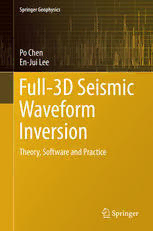Table Of ContentSpringer Geophysics
The Springer Geophysics series seeks to publish a broad portfolio of scientific
books,aimingatresearchers,students,andeveryoneinterestedingeophysics.The
series includes peer-reviewed monographs, edited volumes, textbooks, and con-
ference proceedings. It covers the entire research area including, but not limited
to, applied geophysics, computational geophysics, electrical and electromagnetic
geophysics, geodesy, geodynamics, geomagnetism, gravity, lithosphere research,
paleomagnetism,planetology,tectonophysics,thermalgeophysics,andseismology.
Moreinformationaboutthisseriesathttp://www.springer.com/series/10173
Po Chen • En-Jui Lee
Full-3D Seismic Waveform
Inversion
Theory, Software and Practice
1 C
PoChen En-JuiLee
DepartmentofGeology&Geophysics DepartmentofEarthSciences
UniversityofWyoming NationalChengKungUniversity
Laramie Tainan
Wyoming Taiwan
USA
SpringerGeophysics
ISBN978-3-319-16603-2 ISBN978-3-319-16604-9(eBook)
DOI10.1007/978-3-319-16604-9
LibraryofCongressControlNumber:2015938450
SpringerChamHeidelbergNewYorkDordrechtLondon
(cid:2)c SpringerInternationalPublishingSwitzerland2015
Thisworkissubjecttocopyright.AllrightsarereservedbythePublisher,whetherthewholeorpartof
thematerialisconcerned,specificallytherightsoftranslation,reprinting,reuseofillustrations,recitation,
broadcasting,reproductiononmicrofilmsorinanyotherphysicalway,andtransmissionorinformation
storageandretrieval,electronicadaptation,computersoftware,orbysimilarordissimilarmethodology
nowknownorhereafterdeveloped.
Theuseofgeneraldescriptivenames,registerednames,trademarks,servicemarks,etc.inthispublication
doesnotimply,evenintheabsenceofaspecificstatement,thatsuchnamesareexemptfromtherelevant
protectivelawsandregulationsandthereforefreeforgeneraluse.
Thepublisher,theauthorsandtheeditorsaresafetoassumethattheadviceandinformationinthisbook
arebelievedtobetrueandaccurateatthedateofpublication.Neitherthepublishernortheauthorsor
theeditorsgiveawarranty,expressorimplied,withrespecttothematerialcontainedhereinorforany
errorsoromissionsthatmayhavebeenmade.
Printedonacid-freepaper
Springer International Publishing AG Switzerland is part of Springer Science+Business Media
(www.springer.com)
DedicatedtomyfatherChen,Zhujun;
mymotherBu,Ping
andmywifeYao,Xiaojia
Preface
Full-3Dseismicwaveforminversion(F3DWI)referstoinversionsthatseektomin-
imize the discrepancies between the observed and synthetic seismic waveforms,
wiggle for wiggle, by solving the three-dimensional acoustic or (visco) elastic
wave equations. Its development is important both for the theoretical foundations
of modern quantitative seismology and for the practical applications of seismo-
logical methods in exploring the Earth’s interior. Driven by the rapid advances in
high-performancecomputingtechnologyandefficientnumericalmethodsforsolv-
ing3Dwaveequations,significantprogressesinF3DWIhavebeenmadeinthepast
decade, especially in large-scale structural studies that use passive sources. This
book is derived from what I have learned in the past 10 years. F3DWI is by its
very nature both a theoretical and a practical subject. It requires a certain level of
understanding of the underlying mathematical formulation, a collection of paral-
lelizedsoftwaretoolsandacertainamountofpractice.Inthisbook,Itrytogivean
integratedtreatmentofallthree.
In Chap. 1, I give a brief introduction about the subject of this book and
some discussions that motivates the development of F3DWI. Throughout this
book,aparallelizedfinite-difference(visco)elasticwave-equationsolverisusedfor
demonstration purposes. The mathematical formulation and detailed instructions
about how to set up and run this wave-equation solver for F3DWI purposes are
summarizedinChap.2.
ThetheoreticalframeworkforF3DWIdevelopedinChaps.3–5isquitegeneral
andencompassesboththeadjointmethod(F3DT-AW),whichback-propagatesthe
misfits from the receivers to image structures, and the scattering-integral method
(F3DT-SI), which sets up the Gauss-Newton normal equation by calculating and
storingthesensitivity(Fréchet)kernelforeachmisfit.
The derivation of F3DT-SI in our previous publications requires the use of the
reciprocity principle and the receiver-side Green’s tensor (RGT). In Chap. 3, I
generalize the formulation of F3DT-SI through adjoint analysis and show that the
requirement on reciprocity can be removed by replacing the RGT with the time-
reversedadjointGreen’stensor.Thisresultmayopenupthepossibilityofapplying
the“scattering-integral-type”methodsbasedonGreen’sfunctionstoalargerclass
ofinverseproblems,inwhichthereciprocityprinciplemaynothold.InChap.3,I
vii
viii Preface
alsoderivetheadjointrepresentationtheoremanditsapplicationinChap.5simpli-
fiesthederivationoftheadjointmethodforconstructingthegradientoftheobjective
functionandalsotheHessian-vectorproduct.
In our previous publications of F3DT-SI, the data sensitivity (Fréchet) kernels
werederived forthebroadband cross-correlationdelaytimeandamplitudemisfits
with respect to isotropic, elastic model parameters. In Chap. 4, I extend the ker-
nelformulationtoarbitrarymisfitsdefinedforindividualreceivers,receiverarrays,
pressureandrotationalsensors.InChap.4,Ialsoderivethekernelsforanisotropy
andanelasticattenuation.
In Chap. 5, I examine both F3DT-SI and F3DT-AW in the context of numeri-
cal optimization. Possible extensions and some practical aspects of both types of
methods are discussed briefly. Some more detailed discussions about the practical
aspectscanbefoundinChap.6,inwhichIgivedetaileddescriptionsaboutour3D
model for the crustal structure in southern California, CVM-S4.26, as well as the
inversionthatproducedthismodel.
Istartedworkingonthismodelbackin2007whenIwasapostdocattheLamont-
Doherty Earth Observatory (LDEO) of Columnbia University. After I moved to
University of Wyoming in 2008, I kept working on it by myself until En-Jui Lee
joinedmyresearchgroupin2009.Inthenext5–6years,bothEn-JuiandIspenta
lotoftimedevelopingthismodel.AsshowninChaps.2and6andalsoinourjour-
nal publications, CVM-S4.26 can fit a quite extensive collection of seismograms
in southern California (more than 50,000 earthquake seismograms and ambient-
noise Green’s functions) from the first-arriving P-wave to about 30-sec after the
surface wave, almost wiggle by wiggle. CVM-S4.26 reveals small-scale crustal
heterogeneities that were not well imaged in previous crustal-scale tomography
studies.Someofthosesmall-scalefeaturesinCVM-S4.26arehighlyconsistentwith
geology and results from previous localized ray-theoretic travel-time tomography
studies.InChap.6,Ishowmanycross-sectionsthroughouttheentiremodelanddis-
cuss possible correlations with other independent geologic and seismic evidences.
MaterialsinChap.6complementourjournalpublicationsaboutthismodel.
Readers who are not particularly interested in the intricacies of the theoretical
aspects of F3DWI can skip the mathematical formulations and start with descrip-
tionsofthesoftwarepackage,alsonamedF3DWI.Thosedescriptions,instructions
andworkedexamplesofF3DWIaregroupedintosectionswiththetitle“Software”
throughout this book. I wrote most of the Fortran and C/C++ codes for F3DWI
whenIwasdoingmypostdocatLDEOin2006–2007.Theparallelfinite-difference
wave-equation solver, AWP-ODC, was provided by Yifeng Cui and Kim Olsen at
theSouthernCaliforniaEarthquakeCenter(SCEC).Imodifiedittoworkwiththe
rest of my kernel and inversion codes. During the development of CVM-S4.26,
I wrote a command-line user interface using python to simplify and streamline
the entire inversion process based on F3DWI. The scalable, parallel LSQR code,
SPLSQR, for solving very large sparse linear systems associated with the Gauss-
Newton normal equation inF3DT-SI was developed incollaboration withLiqiang
Wang and his students and collaborators at the Computer Science Department in
University of Wyoming. The software and other materials related to the book can
Preface ix
berequestedfromhttp://pochenfullwave.ddns.net.Likemanyotherresearchcodes,
ittakessomeeffortandpracticetofullyunderstandthebehaviorofthesecodesand
tobeabletoeffectivelyutilizethesecodesinrealisticapplications.Yourcomments,
suggestions(ofreferences),questions,correctionsaboutthecodesandthebookare
verymuchappreciatedandpleaseemailthemtopochengeophysics@gmail.comor
[email protected].
IwouldliketothankTomJordan,LiZhaoandXiaofeiChenforteachingmeso
many things about seismology andgeophysics when Iwasastudent. Iwouldalso
liketothankallmystudents,En-JuiLee,DaweiMu,XiaofengZhang,JingXu,and
Wei Wang, for trusting in me and working with me. I would like to thank Jeroen
Tromp for opening my eyes to the adjoint method during the 2003 Caltech-USC
readingclassonwaveformtomography.Thelastchapterofthisbookbenefitedfrom
constructive discussions with Tom Jordan, David Okaya, John Platt, Ken Dueker
andDerekSchutt.Iwouldliketothankallmycollaboratorsinthepastfewyears,
Phillip Maechling, Marine Denolle, Greg Beroza, Liqiang Wang, He Huang, John
Dennis,YoulinChen,ZhiguoXu,DanielO’Connell,PengchengLiuandSatishPul-
lammanappallil. The Department of Geology and Geophysics and the School of
Energy Resources (SER) at University of Wyoming have been very supportive on
my research. Grants from the NSF, USGS, AFRL, SCEC, SER, Anadarko, Fugro
ConsultantsIncandOptimSoftwareLLCareverymuchappreciated.
01/19/2015 PoChen
Contents
1 Introduction................................................... 1
1.1 AdvantagesoftheSeismicRayMethod........................ 2
1.2 DrawbacksoftheSeismicRayMethod ........................ 3
1.3 NumericalSolutionsoftheSeismicWaveEquation .............. 4
1.4 ABriefHistoryofHPCTechnology........................... 7
References..................................................... 11
2 AnelasticWavePropagation(AWP) .............................. 15
2.1 Formulation ............................................... 17
2.1.1 ElasticMedia ....................................... 17
2.1.2 ViscoelasticMedia................................... 18
2.1.3 Discretization ....................................... 31
2.1.4 Free-SurfaceBoundary ............................... 34
2.1.5 PMLBoundary...................................... 36
2.1.6 InternalWeldedMaterialInterfaces ..................... 40
2.1.7 SourceRepresentation ................................ 42
2.2 Software.................................................. 43
2.2.1 MeshGeneration .................................... 45
2.2.2 StructuralModel..................................... 49
2.2.3 ParameterFile....................................... 53
2.2.4 SourcesandReceivers ................................ 57
2.2.5 RecordingGridPoints ................................ 64
2.2.6 WavefieldSimulation................................. 66
2.2.7 SyntheticSeismograms ............................... 70
2.2.8 Half-SpaceExampleSummary......................... 73
2.3 Application................................................ 77
2.3.1 SCECCommunityVelocityModels(CVMs) ............. 77
2.3.2 EarthquakeSourceModels ............................ 78
2.3.3 ValidationofSCECCVMs ............................ 79
References..................................................... 86
xi

